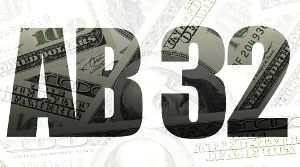Warnings about AB32 sink in with national media
 Since California’s adoption of Assembly Bill 32 in 2006, business interests have emphasized the law’s long-term effects on economic competitiveness. The measure requires the state to shift to cleaner-but-costlier forms of energy, reaching 33 percent of electricity supplies by 2020.
Since California’s adoption of Assembly Bill 32 in 2006, business interests have emphasized the law’s long-term effects on economic competitiveness. The measure requires the state to shift to cleaner-but-costlier forms of energy, reaching 33 percent of electricity supplies by 2020.
The peer review of the California Air Resources Board’s 2007 report on the economic impact of the law included criticism from a UCLA professor and other academics who faulted the air board for failing to acknowledge the law’s likely eventual impact on manufacturing, in particular. The air board has been more candid about the AB32 economic fallout since then. In 2009, officials warned of what is known as “leakage”:
Producers that face compliance costs may not be able to pass costs through to consumers because their competitors that do not face similar costs do not have to increase prices. … Industries in this category may include non-ferrous metals smelting, iron and steel-making, cement, and other energy and/or emissions intensive activities.
But the typical California coverage of AB32 rarely discusses this prospect. Instead, it often uncritically accepts the idea that green jobs created directly and indirectly by AB32 will be its primary economic effect.
‘Manufacturers are the canaries’
But the national media generally look at the law differently. Bloomberg news service offered the latest example with a Feb. 5 story:
California manufacturers from food processors to apparel makers are warning costs will skyrocket if state regulators proceed with a plan to reduce their allocations of free greenhouse gas emission credits.
Starting in 2018, some companies California considers to be at risk of losing business to competitors outside the state’s landmark emissions cap and trade market will receive up to 50 percent fewer free pollution credits. That means they will either have to buy more allowances at auction or invest in ways to cut carbon pollution even more.
California has the toughest greenhouse gas curbs in the U.S., seeking to cut discharges to 1990 levels by 2020. The pushback from industry comes as Governor Jerry Brown and other state Democratic leaders are looking to advance those climate change policies further even as business leaders warn that lack of a national and global carbon-emission market puts companies in the state at a competitive disadvantage.
“Manufacturers are the canaries,” said Dorothy Rothrock, president of the California Manufacturers & Technology Association. “All of the costs in this system are radiating up and concentrate in manufacturing. It’s cumulative and it’s not happening anywhere else like this. California is doing it to its manufacturers in a way that no other state is contemplating.”
NYT: ‘Risks for CA are enormous’
In 2012, The New York Times offered a similar take about California’s “grand experiment”:
The outsize goals of California’s new law, known as A.B. 32, are to lower California’s emissions to what they were in 1990 by 2020 — a reduction of roughly 30 percent — and, more broadly, to show that the [cap and trade system of selling emission rights] works and can be replicated.
The risks for California are enormous … the program could hurt the state’s fragile economy by driving out refineries, cement makers, glass factories and other businesses. Some are concerned that companies will find a way to outmaneuver the system, causing the state to fall short of its emission reduction targets.
“The worst possible thing to happen is if it fails,” said Robert N. Stavins, a Harvard economist.
The contrast with California media is pronounced. A Los Angeles Times editorial about AB 32 from last summer, for example, doesn’t even mention the law’s economic risks. Nor does this story from November about how an Indian tribe is taking advantage of one of the law’s provisions.
But the Times did acknowledge concerns that AB 32 would force the cost of gasoline higher for motorists. The effects of higher energy costs on business were not mentioned, however.
Chris Reed
Chris Reed is a regular contributor to Cal Watchdog. Reed is an editorial writer for U-T San Diego. Before joining the U-T in July 2005, he was the opinion-page columns editor and wrote the featured weekly Unspin column for The Orange County Register. Reed was on the national board of the Association of Opinion Page Editors from 2003-2005. From 2000 to 2005, Reed made more than 100 appearances as a featured news analyst on Los Angeles-area National Public Radio affiliate KPCC-FM. From 1990 to 1998, Reed was an editor, metro columnist and film critic at the Inland Valley Daily Bulletin in Ontario. Reed has a political science degree from the University of Hawaii (Hilo campus), where he edited the student newspaper, the Vulcan News, his senior year. He is on Twitter: @chrisreed99.
Related Articles
Names! All I wanted were names!
Just thought I’d blog for a bit about the journalistic process, as it pertains to my Jan. 15 column “Using
Rex Hime paves way for split rolls
Steven Greenhut: Rex Hime is president of the California Business Properties Association, a trade group representing commercial property owners, and
Are 'neo-Confederates' holding up Obamacare?
Are “neo-Confederates” shutting down the government and wrecking the Constitution by trying to de-fund Obamacare? So claims longtime Republican staffer



